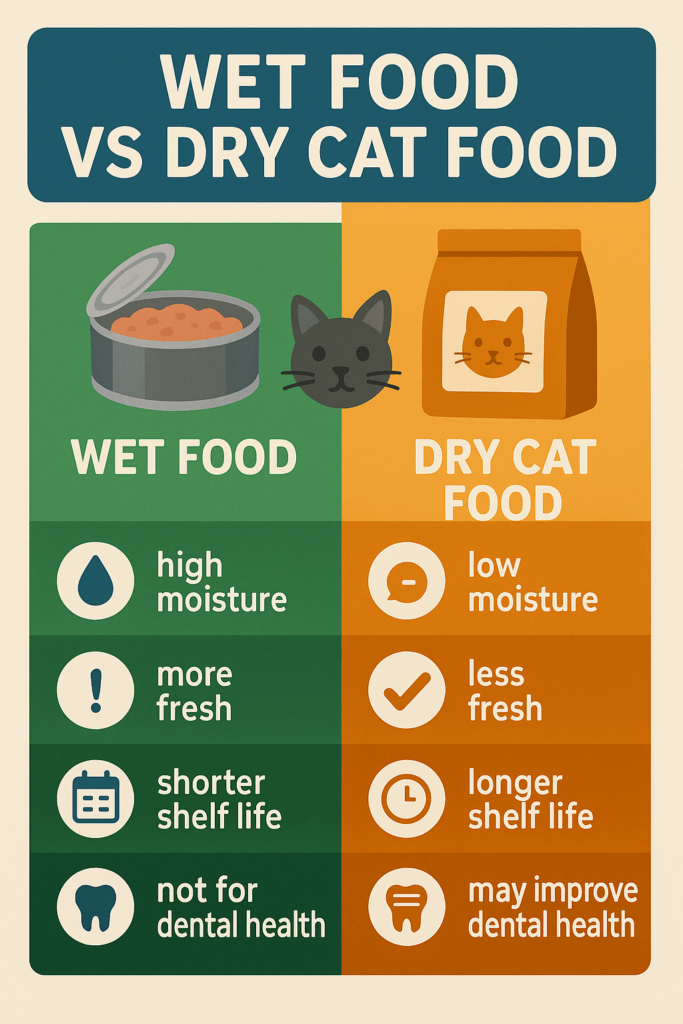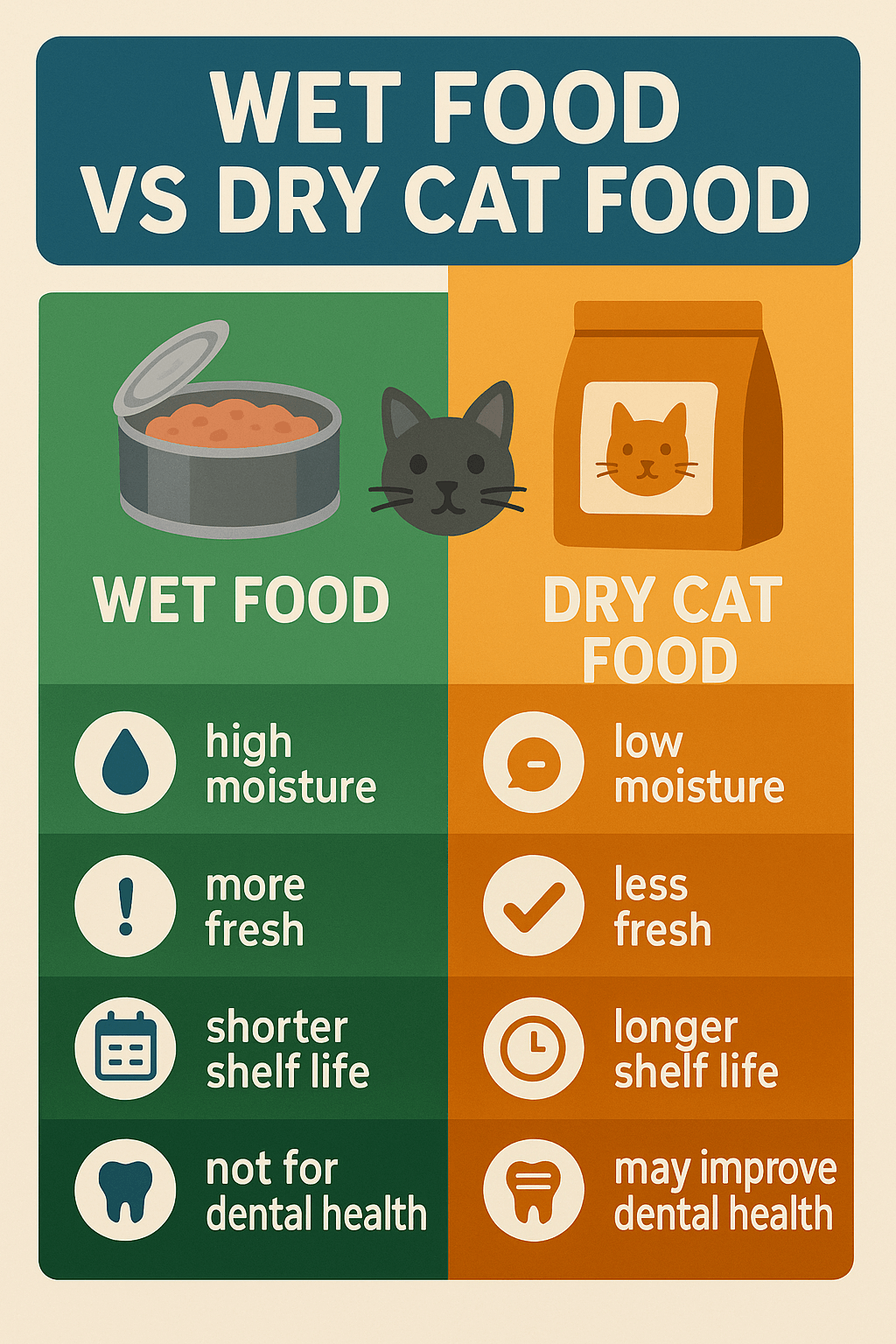Wet Food vs Dry Cat Food: What’s Best for Your Feline Friend?
Choosing the right food for your cat is one of the most important decisions you’ll make as a pet owner. With so many options available, the debate between wet food and dry cat food often leaves owners wondering which is better. Both types have their advantages and drawbacks, and understanding these differences can help you make an informed choice tailored to your cat’s unique needs. From hydration and nutrition to convenience and budget, we’ll explore everything you need to know about wet food vs dry cat food to ensure your furry companion stays happy and healthy.
Expert Insight on Cat Food Composition
“Dry cat food contains approximately 10% of water, and the other 90% consists of dry matter such as carbohydrates, fats and vitamins. Canned food contains much more water—approximately 70%—compared to dry matter.”
Nutritional Benefits of Wet Cat Food
Wet cat food is known for its high moisture content, making it a popular choice for cats who struggle to stay hydrated. Here are some key nutritional benefits of wet food that set it apart from dry alternatives.
High Moisture Content:
Wet food contains up to 78% water, which helps keep your cat hydrated and supports urinary tract health.Rich in Protein:
Many wet foods are formulated with high-quality animal proteins, closely mimicking a cat’s natural diet in the wild.Lower Carbohydrates:
Compared to dry food, wet food typically has fewer carbohydrates, which aligns better with a cat’s carnivorous nutritional needs.Palatability:
The strong aroma and texture of wet food often appeal to picky eaters, encouraging them to finish their meals.Supports Weight Management:
The higher water content in wet food can help cats feel fuller, reducing the risk of overeating and obesity.
For cats prone to dehydration or those with specific dietary needs, wet food offers numerous advantages that contribute to overall health and well-being.

Advantages of Dry Cat Food
While wet food has its perks, dry cat food remains a staple for many households due to its practicality and affordability. Here’s why dry food continues to be a popular choice among cat owners.
Convenience:
Dry food is easy to store, doesn’t spoil quickly, and can be left out for free-feeding without the risk of spoiling.Cost-Effective:
On average, dry food is more affordable than wet food, making it a budget-friendly option for multi-cat households.Dental Health Benefits:
Some dry kibble formulas are designed to reduce plaque and tartar buildup, promoting better oral hygiene.Portion Control:
Dry food allows for precise portioning, helping owners manage their cat’s calorie intake more effectively.Variety of Options:
From grain-free to hypoallergenic formulas, dry food offers a wide range of choices to suit different dietary requirements.
Dry cat food’s versatility and accessibility make it a practical solution for busy pet owners seeking a balanced diet for their feline companions.
Check this guide 👉Cat Food vs Dog Food: Best 7 Expert Tips!
Check this guide 👉Top 5 Grain-Free Wet Cat Foods for Ultimate Feline Health!
Check this guide 👉Top 5 Essential Cat Food Mats for Ultimate Cleanliness!
Benefits of Wet Cat Food | Benefits of Dry Cat Food |
|---|---|
High moisture content for hydration | Convenient storage and longer shelf life |
Rich in protein and low in carbs | Affordable and cost-effective |
Appeals to picky eaters | Supports dental health with certain formulas |
Helps maintain healthy weight | Easy portion control for feeding |
Ideal for cats with urinary issues | Wide variety of flavors and formulas |
Potential Drawbacks of Wet Cat Food
While wet food offers many benefits, it’s not without its downsides. Understanding these limitations can help you weigh the pros and cons before making a decision.
Higher Cost:
Wet food is generally more expensive per serving compared to dry food, which may strain tight budgets.Short Shelf Life After Opening:
Once opened, wet food must be refrigerated and consumed within a few days, leading to potential waste if not eaten promptly.Messier to Serve:
Wet food can be sticky and harder to clean up, requiring more effort during meal preparation and cleanup.Not Ideal for Free-Feeding:
Unlike dry food, wet food cannot be left out for extended periods, making it less convenient for cats that graze throughout the day.Limited Dental Benefits:
Wet food does not provide the same mechanical cleaning action as dry kibble, potentially increasing the risk of dental issues.
Considering these drawbacks ensures you’re prepared for the challenges that come with feeding wet food to your cat.
Potential Drawbacks of Dry Cat Food
Dry cat food, while convenient, also has its share of disadvantages. Being aware of these factors can help you determine whether it meets your cat’s needs.
Low Moisture Content:
Dry food contains only about 10% moisture, which may not provide enough hydration for cats prone to urinary issues.Higher Carbohydrate Levels:
Many dry formulas include fillers like grains or starches, which can be problematic for cats requiring low-carb diets.Less Appealing to Picky Eaters:
Some cats find dry food less enticing due to its lack of aroma and softer texture compared to wet food.Risk of Overeating:
Free-feeding dry food can lead to overconsumption, contributing to obesity and related health problems.Quality Variability:
Not all dry foods are created equal, and lower-quality options may lack essential nutrients or contain harmful additives.
Balancing the pros and cons of dry food is crucial to ensuring your cat receives the nutrition they need without compromising their health.
Signs Your Cat Prefers Wet Food
Some cats show clear preferences when it comes to their food. These signs indicate that your cat might lean toward wet food as their primary choice.
Leaves Dry Food Uneaten:
If your cat consistently ignores dry kibble but eagerly devours wet food, it’s a strong indicator of their preference.Increased Water Consumption:
Cats eating mostly dry food may drink more water to compensate for the lack of moisture in their diet.Excitement During Meal Prep:
Your cat may meow or follow you around when you prepare wet food, showing heightened anticipation.Avoids Crunchy Textures:
Some cats dislike the hard texture of dry food and prefer the softer consistency of wet options.Improved Appetite with Wet Food:
A cat that eats more enthusiastically with wet food may simply enjoy the taste and texture better.
Recognizing these signs can help you tailor your cat’s diet to their liking, ensuring they enjoy mealtime every day.
How to Transition Between Wet and Dry Food
Switching your cat’s diet requires patience and care to avoid digestive upset. Follow these steps for a smooth transition between wet and dry food.
Introduce Gradually:
Start by mixing a small amount of the new food with their current diet, slowly increasing the ratio over 7-10 days.Monitor for Digestive Issues:
Watch for signs of vomiting, diarrhea, or constipation during the transition period and adjust accordingly.Use Positive Reinforcement:
Reward your cat with praise or treats when they try the new food to create positive associations.Maintain Consistent Feeding Times:
Stick to regular feeding schedules to minimize stress and confusion during the switch.Consult Your Veterinarian:
If your cat has health conditions or food sensitivities, seek professional guidance before making changes.
A gradual approach ensures your cat adapts comfortably to their new diet without unnecessary stress.
Homemade Alternatives to Wet and Dry Food
If you’re considering homemade options, there are ways to supplement or replace commercial wet and dry food. These alternatives offer fresh, nutritious choices for your cat.
Cooked Meat Recipes:
Plain, cooked chicken, turkey, or beef can serve as protein-rich additions to your cat’s meals. Avoid seasoning or spices.Blended Meat Mixtures:
Blend cooked meat with water or broth to create a pâté-like consistency similar to wet food.Raw Diets:
Some owners opt for raw meat diets, though these require careful planning to ensure balanced nutrition.Homemade Kibble Substitutes:
Dehydrated meat chunks or baked liver treats can mimic the crunch of dry food while offering healthier ingredients.Supplement with Essential Nutrients:
Add taurine, vitamins, and minerals to homemade meals to meet your cat’s dietary requirements.
Homemade options provide flexibility but should always be approached with caution and veterinary approval to ensure safety and balance.
Frequently Asked Questions About Wet Food vs Dry Cat Food
Can I mix wet and dry food?
Yes, combining wet and dry food can provide the benefits of both, offering variety and meeting hydration needs.
Is wet food better for senior cats?
Wet food is often recommended for older cats due to its soft texture and high moisture content, which support aging bodies.
How much should I feed my cat daily?
Portion sizes depend on your cat’s age, weight, and activity level. Consult your vet for personalized feeding guidelines.
Does dry food cause urinary problems?
Cats fed exclusively dry food may be at higher risk for urinary issues due to its low moisture content. Supplementing with wet food can help.
What if my cat refuses to eat dry food?
Try mixing it with wet food or gradually introducing it alongside their preferred meals to encourage acceptance.
Finding the Right Balance for Your Cat’s Diet
The debate between wet food and dry cat food ultimately comes down to your cat’s individual needs, preferences, and lifestyle. While wet food excels in hydration and palatability, dry food shines in convenience and affordability. By understanding the strengths and limitations of each type, you can create a feeding plan that keeps your cat healthy, satisfied, and thriving. Whether you choose one over the other or combine both, the most important thing is to prioritize quality nutrition and consult your veterinarian for tailored advice. After all, a happy cat starts with a well-balanced diet!
Can a Cat Die from a Cold? Best 7 Expert Tips! Learn how to identify, treat, and prevent feline colds while understanding when to seek veterinary care for your cat’s health.
Cat Screaming for Food: Best 7 Expert Tips! Discover effective strategies to manage your cat's food-related vocalizations and create a peaceful feeding routine.
Aspiration Pneumonia in Cats: Best 7 Expert Tips! Discover causes, symptoms, and treatment advice to protect your cat’s respiratory health and ensure a speedy recovery.
Hip Dysplasia in Cats: Best 7 Expert Tips! Discover expert advice on managing hip dysplasia in cats, from symptoms and prevention to treatment options for a happier, healthier feline life.





